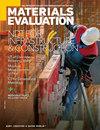基于钨带灯的比率式轴上熔池监测光电探测器系统的热校准
IF 0.3
4区 材料科学
Q4 MATERIALS SCIENCE, CHARACTERIZATION & TESTING
引用次数: 1
摘要
熔池原位监测是一套广泛应用于工业金属激光粉末床聚变(LPBF)增材制造(AM)系统的技术。本研究调查了使用校准的钨带灯作为参考标准来校准基于光电探测器的轴熔池监测系统。校准演示了两个功能:(a)启用用于测量和确保系统可重复性的参考,以及(b)启用基于测量的光电探测器信号的物理温度值的参考。本文探讨了第二个函数。基于双色普朗克测温理论,推导了一个基于回归的模型。然后将校准后的钨灯放置在LPBF系统中,并在不同的灯温度设定点测量得到的光电探测器信号,以校准模型。最后,给出了几个额外的表征测试及其结果,验证了灯的时间响应、作为采样时间函数的测量噪声、LPBF光学器件的光谱测量及其对温度校准的潜在影响。还开发了一个框架来规范整个构建板的温度读数,以去除与位置相关的光学伪影。本文章由计算机程序翻译,如有差异,请以英文原文为准。
Thermal Calibration of Ratiometric, On-Axis Melt Pool Monitoring Photodetector System Using Tungsten Strip Lamp
In situ melt pool monitoring is a set of technologies widely deployed on industrial, metals-based laser powder bed fusion (LPBF) additive manufacturing (AM) systems. This study investigates the use of a calibrated tungsten ribbon lamp as a reference standard to calibrate a photodetector based, on-axis melt pool monitoring system. Calibration demonstrates two functions: (a) enable a reference for measuring and ensuring system repeatability, and (b) enable reference to physical temperature values based on the measured photodetector signals. The second function is explored in this paper. A regression-based model is derived based on bichromatic Planck thermometry theory. The calibrated tungsten lamp is then placed within a LPBF system, and resulting photodetector signals are measured at different lamp temperature set points to calibrate the model. Finally, several additional characterization tests and their results are presented verifying the temporal response of the lamp, measurement noise as a function of sampling time, and spectroscopic measurements of the LPBF optics and their potential effect on temperature calibration. A framework is also developed to normalize temperature readings across the build plate to remove location-dependent optical artifacts.
求助全文
通过发布文献求助,成功后即可免费获取论文全文。
去求助
来源期刊

Materials Evaluation
工程技术-材料科学:表征与测试
CiteScore
0.90
自引率
16.70%
发文量
35
审稿时长
6-12 weeks
期刊介绍:
Materials Evaluation publishes articles, news and features intended to increase the NDT practitioner’s knowledge of the science and technology involved in the field, bringing informative articles to the NDT public while highlighting the ongoing efforts of ASNT to fulfill its mission. M.E. is a peer-reviewed journal, relying on technicians and researchers to help grow and educate its members by providing relevant, cutting-edge and exclusive content containing technical details and discussions. The only periodical of its kind, M.E. is circulated to members and nonmember paid subscribers. The magazine is truly international in scope, with readers in over 90 nations. The journal’s history and archive reaches back to the earliest formative days of the Society.
 求助内容:
求助内容: 应助结果提醒方式:
应助结果提醒方式:


